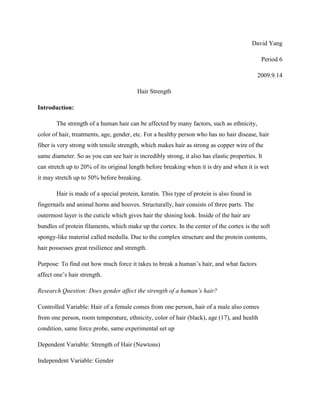
AoK Science
- 1. David Yang<br />Period 6 <br />2009.9.14<br />Hair Strength<br />Introduction:<br />The strength of a human hair can be affected by many factors, such as ethnicity, color of hair, treatments, age, gender, etc. For a healthy person who has no hair disease, hair fiber is very strong with tensile strength, which makes hair as strong as copper wire of the same diameter. So as you can see hair is incredibly strong, it also has elastic properties. It can stretch up to 20% of its original length before breaking when it is dry and when it is wet it may stretch up to 50% before breaking.<br />Hair is made of a special protein, keratin. This type of protein is also found in fingernails and animal horns and hooves. Structurally, hair consists of three parts. The outermost layer is the cuticle which gives hair the shining look. Inside of the hair are bundles of protein filaments, which make up the cortex. In the center of the cortex is the soft spongy-like material called medulla. Due to the complex structure and the protein contents, hair possesses great resilience and strength.<br />Purpose: To find out how much force it takes to break a human’s hair, and what factors affect one’s hair strength.<br />Research Question: Does gender affect the strength of a human’s hair?<br />Controlled Variable: Hair of a female comes from one person, hair of a male also comes from one person, room temperature, ethnicity, color of hair (black), age (17), and health condition, same force probe, same experimental set up<br />Dependent Variable: Strength of Hair (Newtons)<br />Independent Variable: Gender <br />*Information on hair strength from http://www.keratin.com/aa/aa016.shtml, http://thebeautybrains.com/2006/04/18/what-is-hair-made-of/<br />Materials:<br />Computer<br />Notebook<br />Pencil<br />Scissor<br />Force Probe<br />Hair <br />Latex gloves<br />Ring Stand<br />Motion Detector<br /> <br />Figure#1: Testing how much strength it takes to break the hair <br /> <br /> <br />Figure#2: Set up of the materials used<br />Procedure: <br />First, discuss what factors might affect the strength of human hair. Secondly, create a data table in your notebook to enter the data. Then, set up force probes and calibrate start to measure the breaking strength of hair. Loop a hair over the force probe, grab both ends and pull it straight down until it breaks. Record the highest force (in Newtons) that is required to break the hair. Each person does 10 hairs each. To prevent hair slipping through your fingers, you should wear latex gloves. <br />Data Collection:<br />Data Table#1: David’s and Mischa’s strength of hair (measured in Newtons)<br />Gender/Force needed to break hair (Newtons(Trial 1Trial 2Trial 3Trial 4Trial 5Trial 6Trial 7Trial 8Trial 9Trial 10AverageDavid (male)3.63.763.422.983.44.453.034.12.293.33.533Mischa (female)2.762.192.741.812.602.392.131.992.511.392.253<br />This table shows raw data of hair strength of a male and a female in ten trials. The average force needed to break the hair of male is 3.533 Newtons, and the average force needed to break the hair of female is 2.253 Newtons. <br />Data Processing:<br />T- Test:<br />P value and statistical significance: <br /> The two-tailed P value is less than 0.0001<br /> By conventional criteria, this difference is considered to be extremely statistically significant. <br />Confidence interval:<br /> The mean of Male minus Female equals 1.1820<br /> 95% confidence interval of this difference: From 0.6850 to 1.6790 <br />Intermediate values used in calculations:<br /> t = 4.9970<br /> df = 18<br /> standard error of difference = 0.23<br />Data Table#2: Mean, Standard deviation, Sample size of hair strength of the male and the female<br />GroupMaleFemaleMean3.43302.2510SD0.60620.4383N1010<br />The mean hair strength for male is 3.4330 Newtons, while the mean hair strength for the female is 2.2510 Newtons. It is calculated using the sum of 10 trials and then divided by 10. The Standard Deviation, SD, tells how spread apart the data are away from the mean. The sample size, N, is the number of trials, which is 10 trials. The data in this table are used in the T-Test calculation to suggest whether the mean hair strength of the male and the mean hair strength of the female have significant difference or not. <br />Conclusion:<br />As seen in Graph#1, the strength of human hair can be affected by gender. The average force needed to break David’s hair is 3.433 Newtons, and the average force needed to break Mischa’s hair is 2.253 Newtons. The result of the statistics T-Test suggests that the average strength of the hair of a male is significantly greater than that of the hair of a female. Evaluation:<br />What we could have improved is where we get our hair from, maybe from the same part of our head, so it can be controlled. The length of hair should also be controlled the same. The sample size is not large enough for statistics analysis. Instead of 10 trials for each person, we should have done at least 30 trials so the data would fit the normal distribution.<br />